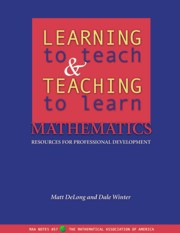Book contents
- Frontmatter
- Preface
- Contents
- 1 The Professional Development Program
- 2 How to Use this Book
- 3 An Orientation Session for the Beginning of the Semester
- 4 Making In-class Groups Work
- 5 Getting Students to Read the Textbook
- 6 Assessing and Evaluating Students' Work
- 7 Managing Homework Teams
- 8 Teaching During Office Hours
- 9 Establishing and Maintaining Control in Your Classroom
- 10 Proctoring Tests and Examinations
- 11 Teaching with Calculators and Computers
- 12 Making Lesson Plans
- 13 Strategies for Motivating Students
- 14 Dealing With Difficult Instructor-Student Situations
- 15 End-of-Semester Administration
- 16 Adapting Materials and Designing Your Own Meetings
- 17 Classroom Visits
- A Tips for Running Meetings
- B The Michigan Introductory Program
- Bibliography
Preface
- Frontmatter
- Preface
- Contents
- 1 The Professional Development Program
- 2 How to Use this Book
- 3 An Orientation Session for the Beginning of the Semester
- 4 Making In-class Groups Work
- 5 Getting Students to Read the Textbook
- 6 Assessing and Evaluating Students' Work
- 7 Managing Homework Teams
- 8 Teaching During Office Hours
- 9 Establishing and Maintaining Control in Your Classroom
- 10 Proctoring Tests and Examinations
- 11 Teaching with Calculators and Computers
- 12 Making Lesson Plans
- 13 Strategies for Motivating Students
- 14 Dealing With Difficult Instructor-Student Situations
- 15 End-of-Semester Administration
- 16 Adapting Materials and Designing Your Own Meetings
- 17 Classroom Visits
- A Tips for Running Meetings
- B The Michigan Introductory Program
- Bibliography
Summary
College and university mathematics departments shoulder a wide range of responsibilities and duties. Perhaps two of the most fundamental missions of any mathematics department are
the creation (or discovery) and preservation of mathematical knowledge, and
the communication of mathematical knowledge (to other professional mathematicians, students and the public).
The purpose of this book is to describe a set of tools and experiences for helping mathematicians to develop and enhance their instructional skills. By instructional skills we mean the ability to represent and communicate mathematical ideas and information to people who are not professional mathematicians. While creating this book, we have focussed on the challenges found in the teaching of undergraduate mathematics—especially the “introductory” classes taken by students at almost every college and university.
An important premise of our work is expressed by our belief that experienced mathematicians have important and unique contributions to make to the development of new mathematics instructors—contributions that cannot always be found in the (necessarily) more generic advice expressed through writings about college teaching and learning in general. As such, this book has been written for use by members of mathematics departments who are accomplished teachers but who do not necessarily have an extensive background in, or experience with, instructor development.
We have used various versions of these training experiences to address the developmental needs of graduate student instructors, post-doctoral and new regular-rank faculty, as well as adjunct and part-time faculty who were new to their institution.
- Type
- Chapter
- Information
- Learning to Teach and Teaching to Learn MathematicsResources for Professional Development, pp. vii - xPublisher: Mathematical Association of AmericaPrint publication year: 2002

